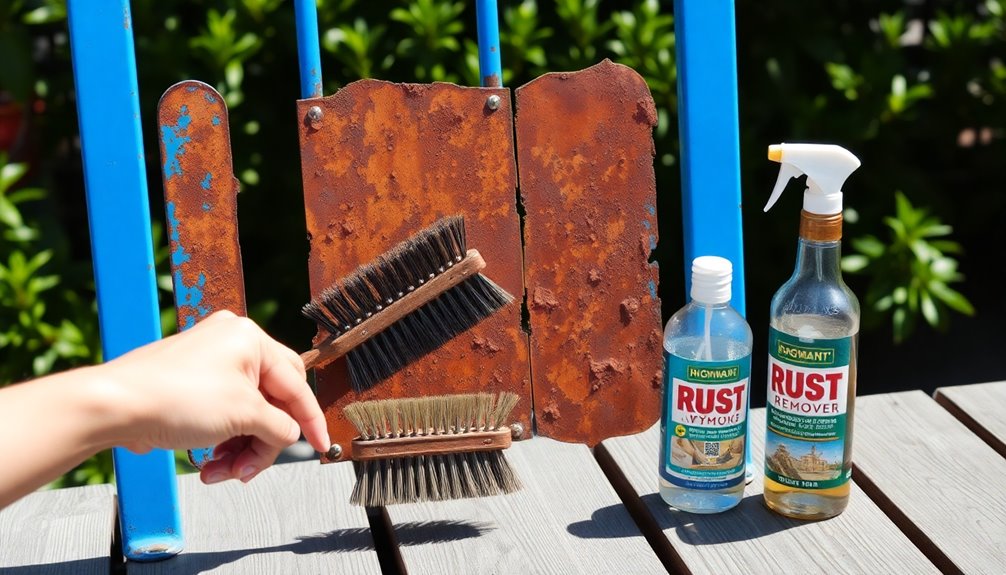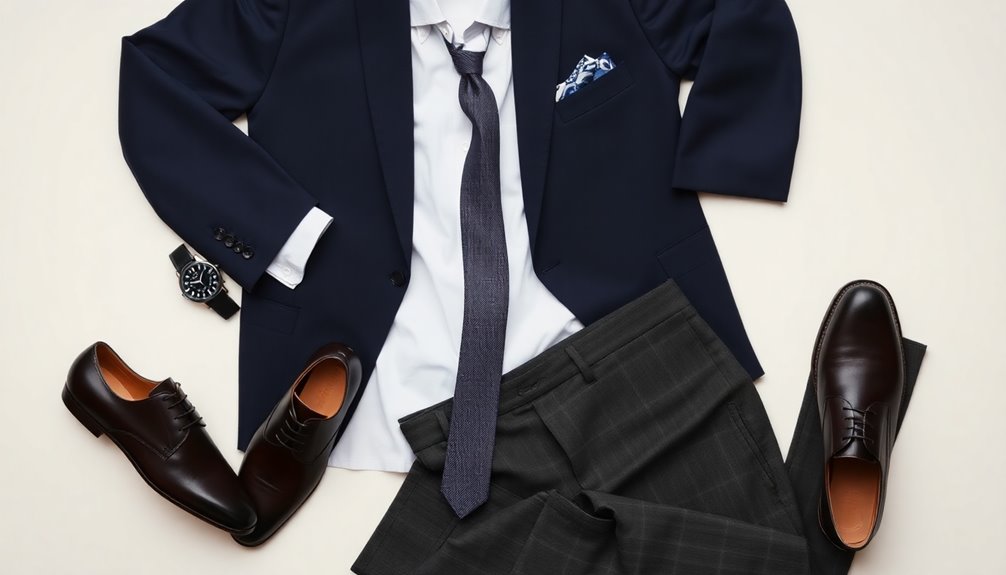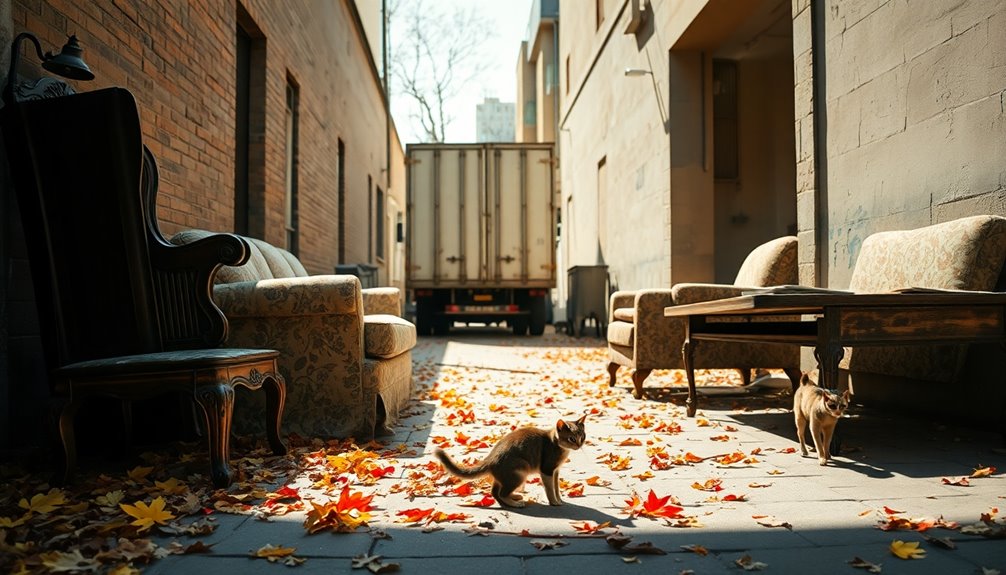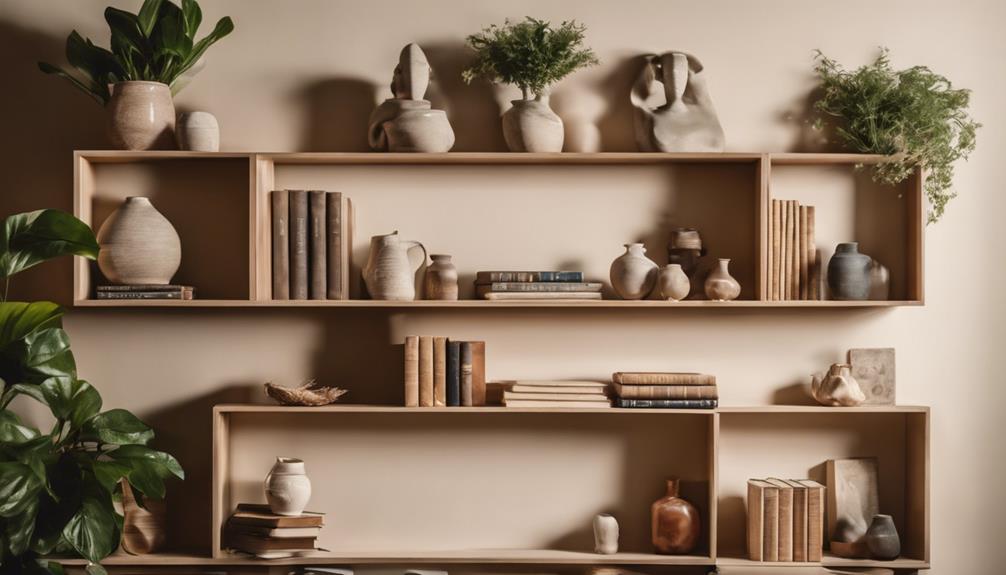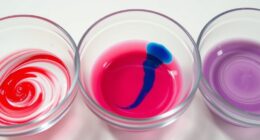To remove rust from metal furniture, start by using common household items. Mix salt and lemon juice to create a paste, applying it directly to rust spots. Alternatively, dampen baking soda and scrub the area gently. White vinegar works wonders, especially when combined with salt. You can also use a halved potato with dish soap to tackle lighter rust. For more stubborn spots, try scrubbing with aluminum foil dipped in vinegar. Always rinse and dry thoroughly afterward to prevent new rust. There are even more effective techniques and maintenance tips that can help keep your furniture in top shape.
Key Takeaways
- Use a mixture of salt and lemon juice to create a paste, applying it to the rusted area to help remove surface rust.
- Scrub the rust with baking soda mixed with water to create a gentle abrasive that prevents scratching.
- Soak the rusted item in white vinegar for an extended period, then scrub with steel wool or a cloth for stubborn rust.
- Use a halved potato with dish soap as a natural scouring pad to remove minor rust spots effectively.
- For severe rust, consider professional restoration services if the corrosion has compromised the furniture's structure.
Understanding Rust on Metal Furniture
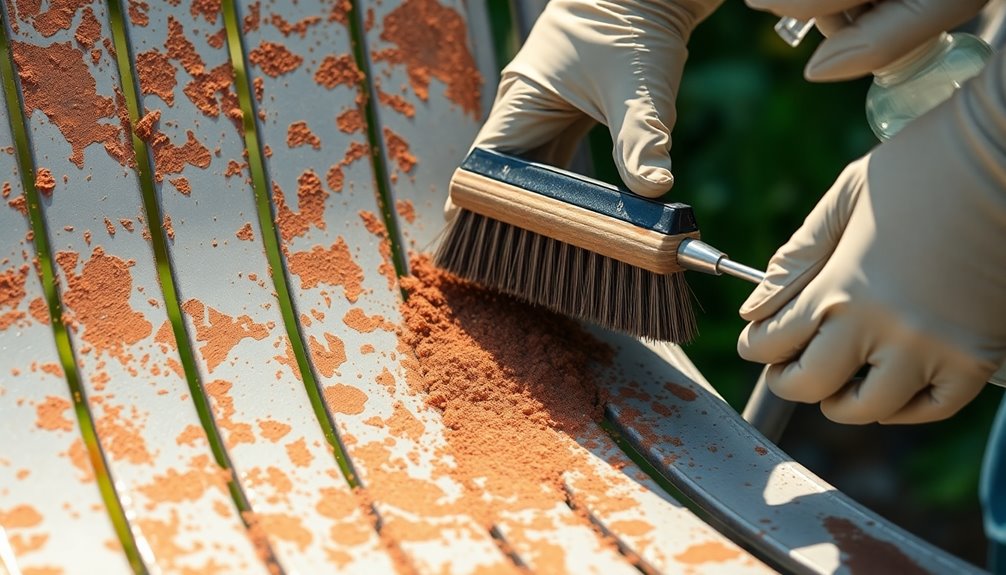
Rust on metal furniture is a common issue that can affect anyone with outdoor or even indoor pieces. It forms when metal gets exposed to moisture and oxygen, leading to a process called oxidation. If you live in a humid environment, you might notice rust appearing more quickly, as high humidity accelerates this process. Additionally, if you're near the sea or use salt on roads, the corrosive nature of salt can further increase rust risk.
Certain metals, like iron and steel, are more prone to rust compared to stainless steel or aluminum. Neglecting to clean and maintain your metal furniture can lead to rust buildup over time. You might see various types of rust, such as surface rust, which is easy to remove, or more serious forms like pitting and scale rust, indicating deeper issues. Regularly applying natural methods for rust removal can help in maintaining the appearance and integrity of your furniture.
Rust can weaken the structure of your furniture, making it unsafe to use, while also damaging its appearance. If left untreated, rust can spread, leading to more extensive repairs. It's crucial to understand these factors to effectively manage and prevent rust on your metal furniture.
Method 1: Salt and Lemon
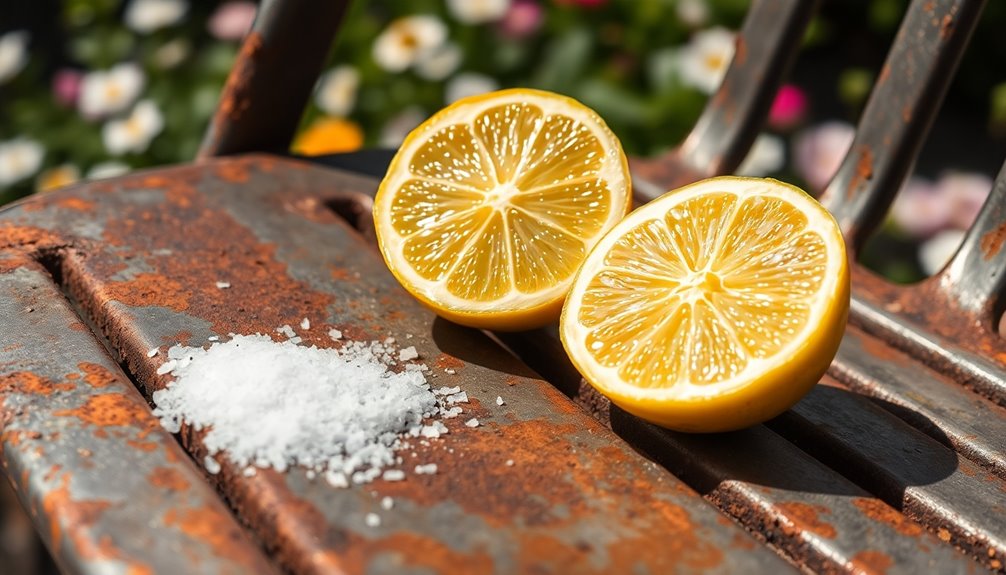
When tackling rust on your metal furniture, one effective and natural method involves using salt and lemon. Start by preparing your mixture—squeeze the juice from a lemon into a bowl and add a generous amount of salt. Aim for a thick consistency so it can stick to the rusty areas. Alternatively, you can sprinkle salt directly on the rust and then drizzle lemon juice over it.
Once your mixture is ready, apply it directly to the rusty spots on your furniture, ensuring complete coverage. For larger items, focus on specific rusty areas or wrap a cloth soaked in the mixture around the affected spots. Allow the mixture to sit for a few hours; for tougher rust, leaving it overnight can yield better results. The acidity of the lemon juice combined with the abrasive salt helps break down the rust. Additionally, be aware that environmental factors like humidity can accelerate rust formation.
After the waiting period, grab an abrasive kitchen sponge or brush and scrub the rusted areas gently but firmly. Once you've removed the rust, rinse the metal thoroughly with water to eliminate any leftover salt. Finally, dry the metal completely to prevent new rust from forming, and repeat if necessary.
Method 2: Baking Soda
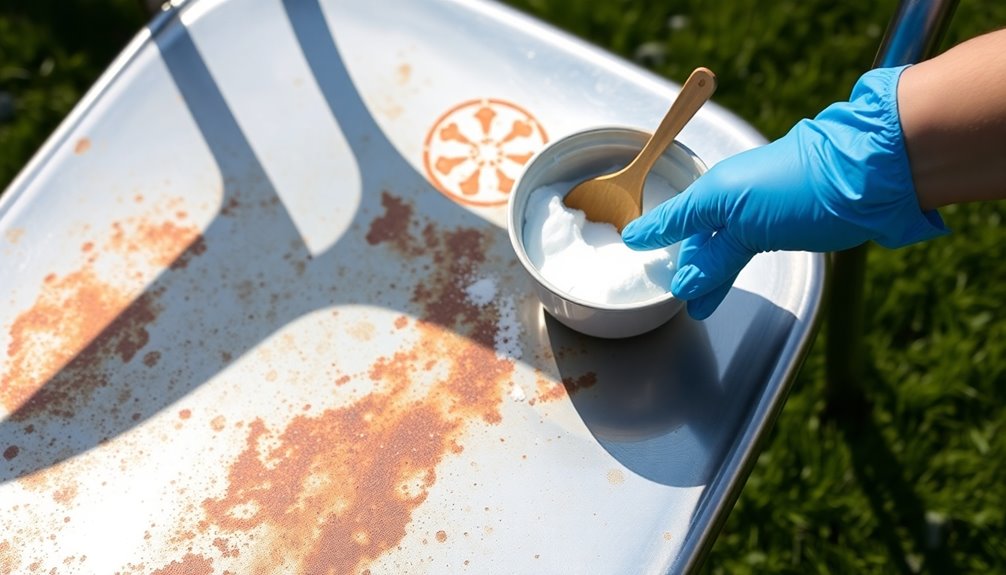
If you're looking for an effective way to tackle rust on your metal furniture, baking soda offers a simple and accessible solution. Start by sprinkling some water onto the rusty area to create a damp surface. Then, apply a generous amount of baking soda to this wet area, ensuring it sticks well. For an even more potent method, you can mix baking soda with a bit of water to create a thick paste. Baking soda is a cost-effective and environmentally friendly solution for rust removal.
Once you've applied the baking soda, wet your scrubbing pad with water and gently scrub the baking soda-covered area. Keeping the scrubbing pad wet helps prevent scratches on the metal surface. Repeat this process—applying baking soda and scrubbing—until all the rust is removed. For lighter rust, you might find that using a soft cloth or a small brush works better.
After you've tackled the rust, rinse the metal object thoroughly to remove any baking soda residue. It's essential to dry the object well to prevent further rusting. Lastly, consider applying paint or oil to protect the metal surface from future rust. Just remember, avoid using hot water, as it can corrode steel.
Method 3: White Vinegar
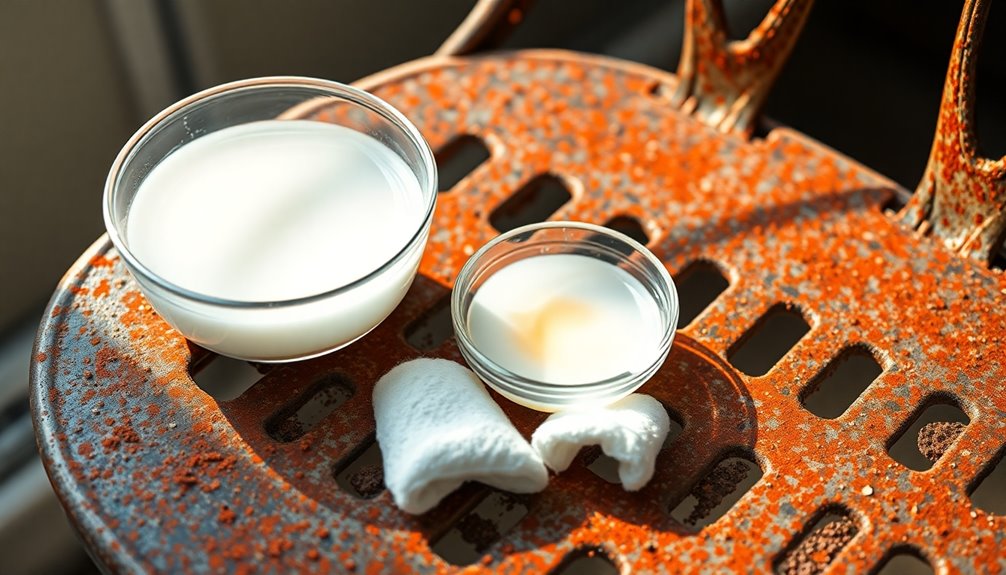
For those dealing with stubborn rust on metal furniture, white vinegar can be a game changer. Start by filling a spray bottle or large container with white vinegar and adding a cup of salt to boost its effectiveness. If your item can be submerged, soak it in the vinegar solution for 10-15 minutes or longer for severe rust, even up to 24 hours if necessary. For surfaces that can't be submerged, soak a rag in vinegar and wrap it around the rusty area.
Once the item has soaked, scrub the rust using steel wool, a metal brush, or a brass-bristled brush. Start gently to avoid damaging the surface, applying more force as needed. If you're working with a surface that can't be submerged, dampen a scouring pad with vinegar and scrub away the rust. After scrubbing, clean the area with a microfiber cloth soaked in a water and baking soda solution to neutralize any remaining acid. Proactive rust removal prevents serious structural issues, making it essential to address rust promptly.
Finally, soak the cleaned item in a baking soda solution for about 10 minutes, scrub again, and dry it completely. Regular maintenance will help keep your metal furniture rust-free.
Method 4: Potato
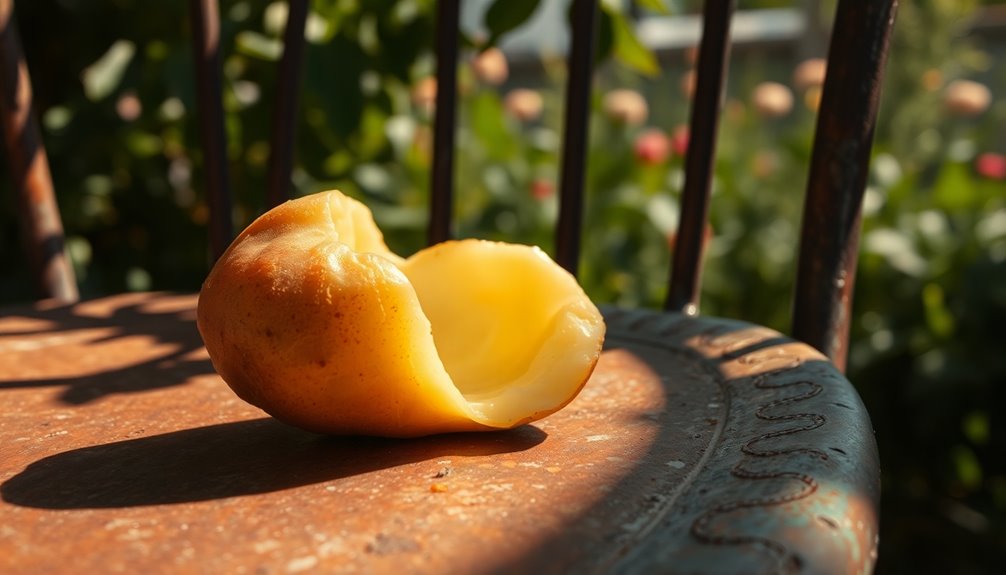
Using a potato to tackle rust on metal furniture might sound unconventional, but it can be surprisingly effective. Start by cutting a potato in half, making sure to choose a Yukon variety with thick skin. Avoid red-skinned potatoes and opt for fresh, crunchy ones for the best results. To enhance the rust removal process, apply salt or dish soap to the cut surface of the potato.
Next, rub the potato half over the rusty area, applying decent pressure. You can also use the skin of the potato to scrub away the rust. If you're using salt, ensure the potato is well-coated for maximum effectiveness. As you scrub, periodically cut the end of the potato half to expose fresh potato and reapply salt as needed. Keep going until you notice the rust starting to flake off.
The oxalic acid in the potato works to dissolve the rust, aided by the salt or dish soap. Potatoes contain oxalic acid that is effective in rust removal, which enhances the cleaning process. If some rust remains, don't hesitate to repeat the process. Once you've removed the rust, clean the area with an old rag, rinse off any residue, and dry the surface to prevent future rust formation.
Method 5: Aluminium Foil and Vinegar

One effective method for removing rust from metal furniture involves the use of aluminum foil and vinegar. Start by gathering your rusted metal items and placing them on a clean cloth. Cut a strip of aluminum foil about 2 or 3 inches wide, or for larger areas, scrunch a foot-long piece into a loose ball. Make sure the aluminum foil is clean and free from debris. Next, dip the aluminum foil in vinegar so that it is saturated but not dripping, then gently scrub the rusted areas of the furniture. The combination of the foil’s texture and the acidity of the vinegar helps to break down the rust effectively. Similarly, if you’re dealing with mold, you might wonder how to eliminate mold on furniture; there are various techniques to tackle that issue as well, including using vinegar or baking soda solutions. Always remember to dry the furniture thoroughly after cleaning to prevent both rust and mold from returning.
Next, prepare a vinegar solution by mixing equal parts water and white vinegar in a spray bottle. You can also pour vinegar into a bowl for easier application on larger projects. Spray the rusted areas directly with the vinegar solution; this helps to break down the oxidized metal. For scrubbing, dip the aluminum foil into the vinegar solution and rub it onto the rusted area. This method is particularly effective because aluminum foil can be used to gently remove rust without scratching the surface. Continue scrubbing until the surface feels smooth and rust-free. If some tough stains remain, you can use steel wool as needed.
Finally, wipe the area with a clean cloth to remove any residue, and pat dry with an old towel. Ensure the metal surface is completely dry to prevent new rust formation, and inspect for any remaining rust before declaring it clean.
Method 6: Other Household Items
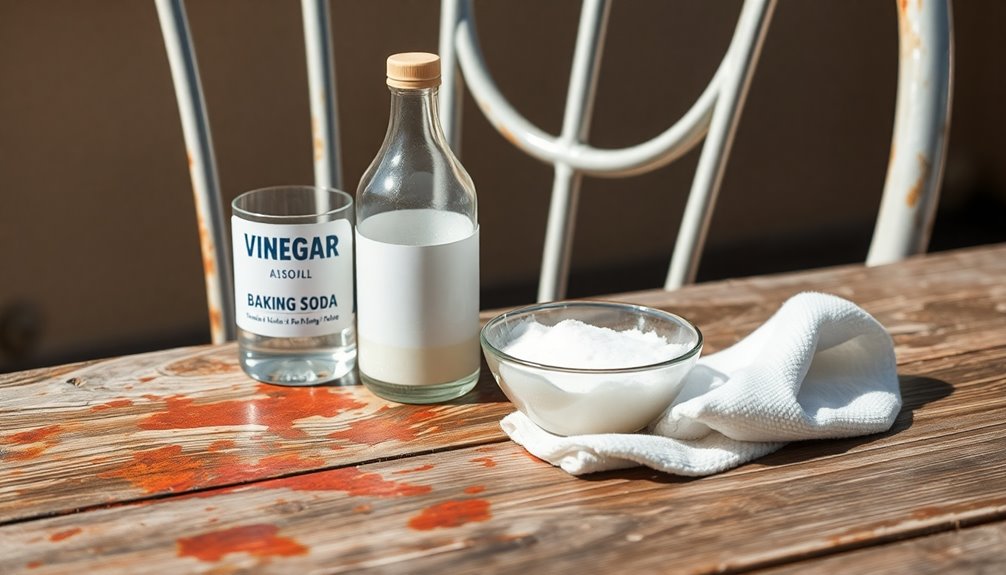
When it comes to removing rust from metal furniture, you can turn to various household items that are likely already in your kitchen. One effective method is mixing lemon juice with salt to create a rust-removing paste. Apply this mixture to the rusty areas and let it sit for a few hours. Afterward, scrub with the lemon rind or an abrasive sponge until the rust is gone. Rinse and dry the surface thoroughly.
Another option is using a potato. Cut one in half, cover the exposed end with dish soap, and use it as a scouring pad on easy-to-reach surfaces. For tougher spots, mix potato juice with dish soap and apply it directly. This method is suitable for removing small rust stains on accessible surfaces.
You can also create a baking soda paste by mixing it with water or hydrogen peroxide for tougher rust. Apply it to the rusty area and let it sit for 15-20 minutes before scrubbing with wire wool.
Lastly, pour cola onto the rusted surface and let it sit for a few minutes, or soak in a mixture of water and blackstrap molasses. Both methods can effectively help dissolve rust. After cleaning, rinse and wipe the surfaces dry.
Tips for Preventing Rust
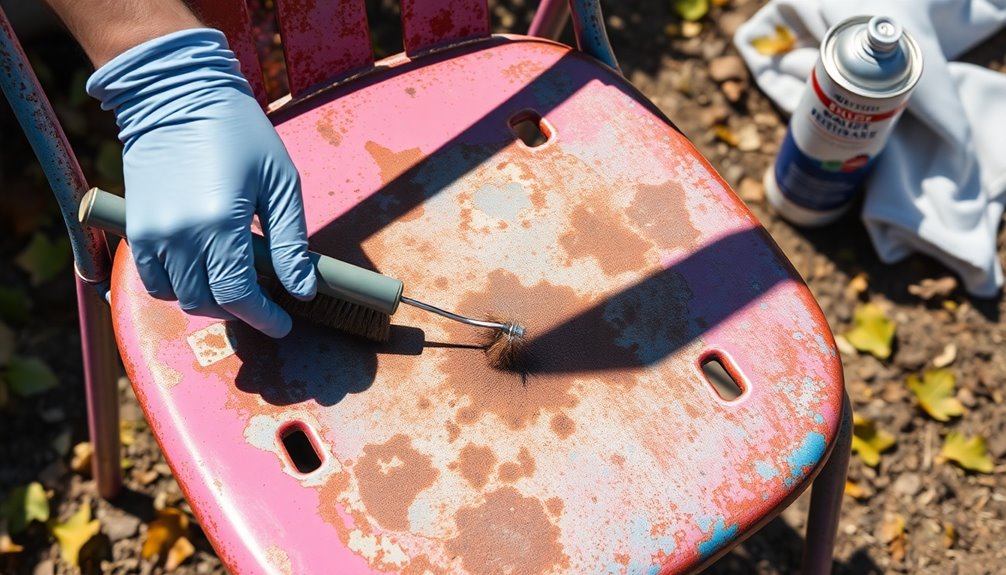
After successfully removing rust from your metal furniture, it's important to consider how to keep it from returning. Start by selecting materials that resist rust, like stainless steel with at least 10.5% chromium or galvanized steel, which is coated with zinc to fend off moisture. If you're designing new furniture, consider using weathering steel that develops a protective rust patina.
Coating your metal pieces can also prevent rust. Apply a layer of powder coating or paint to create a barrier against the elements. You might also use mineral oil, paste wax, or grease for additional protection. Regular inspections can also help identify early signs of rust formation before they become a larger issue.
Protect your furniture with covers when it's not in use and store it in a dry area to minimize moisture exposure. Regularly wipe down surfaces with a soft cloth and anti-rust oil to maintain their integrity.
Finally, consider the environment where your furniture resides. Keep it away from corrosive substances and ensure good drainage around it. By following these tips, you'll extend the life of your metal furniture and keep rust at bay.
Final Touches After Rust Removal
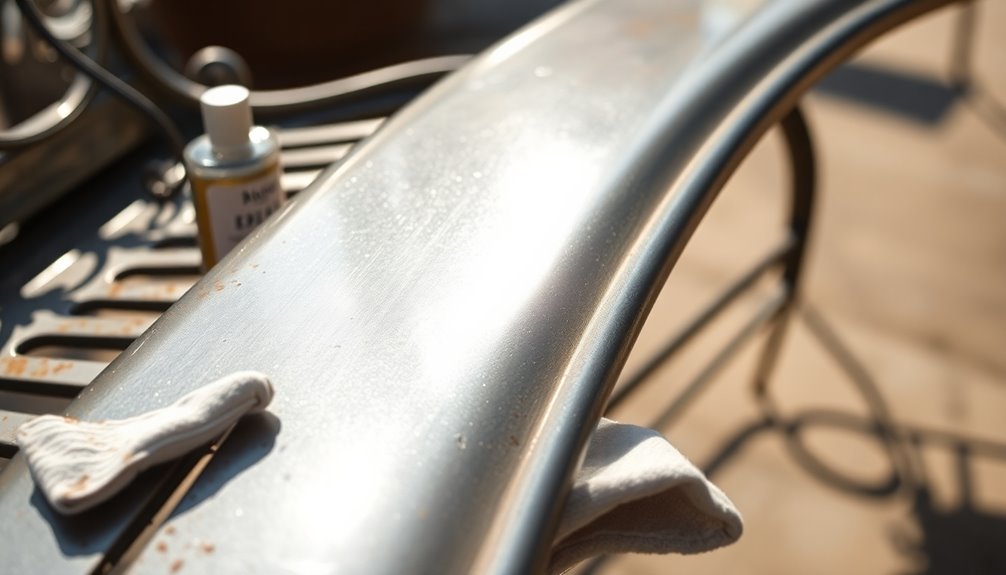
Achieving a polished finish on your metal furniture is essential for both aesthetics and durability. Start by smoothing the surface with fine-grade sandpaper (320-grit or higher) to eliminate any remnants of rust. For polishing, use steel wool to remove leftover particles, applying uniform pressure to avoid scratches. Wipe the surface with a clean towel to clear any debris.
Next, clean the metal by rinsing it with warm water and a light dish soap solution. Scrub the surface with a sponge or soft bristle brush, focusing on hard-to-reach spots. Thoroughly dry the surface with a clean towel to prevent moisture buildup that can lead to rust. If necessary, use a degreaser to remove any lingering oil or grease.
Once the surface is clean and dry, apply a transparent protective coat like varnish or sealer to shield it from moisture and environmental elements. Use small brushes for detailed areas, ensuring even coverage. After allowing the protective coating to dry completely, consider painting with special metal paint in thin layers for a weather-proof finish. This final touch will enhance both the look and longevity of your furniture. Additionally, it is crucial to ensure that the surface is thoroughly clean and dry before painting to promote proper adhesion and prevent paint flaking or peeling, which is vital for preventing rust.
Frequently Asked Questions
Can Rust Be Removed Without Damaging the Metal Surface?
Yes, you can remove rust without damaging the metal surface. You'll want to use gentle methods like vinegar, baking soda, or a salt and lemon mixture. These options react with rust while preserving the underlying metal. Just make sure to scrub lightly and rinse thoroughly afterward. Always test a small area first to ensure no adverse effects occur. Regular maintenance can help prevent rust from forming again, keeping your metal surfaces in great shape.
How Often Should I Check for Rust on My Furniture?
You should check your metal furniture for rust regularly to catch any issues early. Perform seasonal inspections at the start and end of each season, especially after winter or heavy storms. A quick monthly visual check can help you spot any rust spots or flaking paint. Always inspect before storing your furniture and right after cleaning, as these times are crucial for identifying potential rust damage that could worsen over time.
Is It Safe to Use These Methods Indoors?
Yes, it's generally safe to use these methods indoors. Natural options like lemon and salt, baking soda, or white vinegar are non-toxic and safe for most surfaces. Just ensure you have good ventilation and wear gloves to avoid skin irritation. If you choose chemical-based methods, follow the instructions carefully and use them in well-ventilated areas to minimize fume exposure. Always test a small area first to avoid any adverse reactions.
What Types of Metal Are Most Susceptible to Rust?
When considering metal types, you should know that iron and steel are the most susceptible to rust due to their high iron content. Low-chromium stainless steel can also rust in harsh conditions. Uncoated or damaged galvanized steel is at risk if the zinc coating wears off. Additionally, weathered metals exposed to moisture or salt are prone to rust. Regular maintenance can help protect these metals from corrosion.
Can I Prevent Rust Without Applying Chemicals?
Yes, you can prevent rust without applying chemicals. Choose rust-resistant metals like aluminum or stainless steel for your furniture. Regularly clean the surfaces with mild soap and water to keep dirt and moisture at bay. Store your furniture in a dry place and use waterproof covers during wet weather. Additionally, inspect your furniture often to catch any early signs of rust, ensuring your metal pieces stay in great condition for longer.
Conclusion
Now that you know how to remove rust from your metal furniture using various methods, you can easily restore its original look. Remember to follow up with preventive measures to keep rust at bay in the future. Regular cleaning and applying protective coatings can make a big difference. With just a little effort, your furniture can stay beautiful and rust-free for years to come. Enjoy your revitalized pieces and the satisfaction of a job well done!
